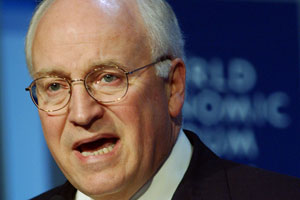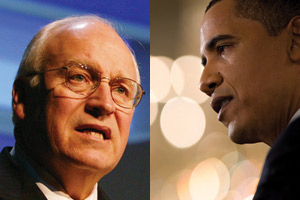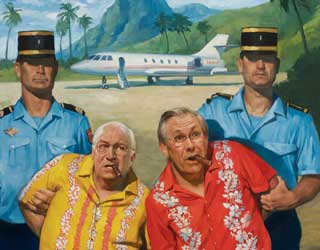
Photo by flickr user <a href="http://www.flickr.com/photos/worldeconomicforum/346771915/">worldeconomicforum</a> used under a <a href="http://www.creativecommons.org">Creative Commons</a> license.
Say what you will about Dick Cheney, at least he’s consistent. While he was in office, the Vice President made a practice of exploiting the fear and loss wrought by the 9/11 attacks to advance his own political agenda—and he’s still doing it now. During his speech at the American Enterprise Institute on Thursday, according to Dana Milbank’s calculations in the Washington Post, “Cheney used the word ‘attack’ 19 times, ‘danger’ and ‘threat’ six times apiece, and 9/11 an impressive 27 times.”
In this putative rebuttal to Obama speech on national security, Cheney described how he spent the morning of 9/11 “in a fortified White House command post,” receiving “the reports and images that so many Americans remember from that day,” and then declared:
In the years since, I’ve heard occasional speculation that I’m a different man after 9/11. I wouldn’t say that. But I’ll freely admit that watching a coordinated, devastating attack on our country from an underground bunker at the White House can affect how you view your responsibilities.
Since he’s evoking his experience as a rationalization for torture, this might be a good time to review exactly what it was that Cheney was doing in the bunker on that terrible day. Here again, consistency is the rule: A preponderance of evidence points to the fact that Dick Cheney spent the morning of September 11, 2001, violating the Constitution of the United States.
I wrote about the subject in my 2005 book The Five Unanswered Questions About 9/11. Based on the 9/11 Commission Report and a number of other sources (all of them public), I offered an account of how Cheney swept aside the Constitution, the laws governing military action, and a host of expert advisors, in the atmosphere of a palace coup. While President Bush was being shuttled around on Air Force One, the Vice President took charge of the country. Here’s an excerpt from the book:
Presidential power is supposed to reside not in the Oval Office, but with the man, wherever he happens to be–whether in a remote military bunker or an elementary school classroom, or in the skies aboard Air Force One. But if any locus of government power existed on 9/11, it was not with President Bush, but rather in the Presidential Emergency Operations Center (PEOC), the bunker beneath the East Wing of the White House, where Vice President Dick Cheney arrived, by his own account, shortly before 10:00 a.m.
Cheney was not alone in the PEOC, but his companions appear to have remained largely silent, deferring in all things to the Vice President. Secretary of Transportation Norman Minetta, who had oversight of the Federal Aviation Administration, made his way to the bunker but didn’t do much there. (He later told the 9/11 Commission that he had ordered all planes grounded at 9:45—but this decision was actually made independently by FAA National Operations Manager Ben Sliney, who was in his first day on the job.) National Security Adviser Condoleeza Rice, always highly political and extremely deferential, remained low-key during what should have been a pivotal moment for her office.
The others who joined Cheney in the PEOC were not experts on terrorism, national security, civilian aviation, or military tactics, but a group of key right-wing political operatives. They included conservative media celebrity and then White House “counselor” Mary Matalin and longtime Bush campaign crony and White House Communications Director Karen Hughes, as well as Cheney’s Chief of Staff, Scooter Libby, a leading neocon foreign policy strategist, and Cheney’s wife, Lynne, a powerful conservative ideologue in her own right, who was escorted to her husband’s side by the Secret Service.
According to “counterterrorism czar” Richard Clarke, a lone holdover from the previous administration, the PEOC was connected by telephone to a videoconference going on in the West Wing’s Situation Room. This conference, at various points, included high-ranking officials from the Defense and State Departments, Joint Chiefs of Staff, Attorney General’s office, CIA, FBI, and FAA. Within half an hour of the second WTC attack, teleconferences had also been established by the FAA and the Pentagon’s National Military Command Center (NMCC).
But the the far more political group in the East Wing’s PEOC seems to have had little use for Clarke’s gathering of experts. In his book Against All Enemies, Clarke reports that someone in the PEOC later told him that attempts to listen in on the West Wing videoconference on speakerphone were impeded “because Mrs. Cheney keeps turning down the volume on you so she can hear CNN . . . and the Vice President keeps hanging up the open line to you.”
The central decision faced by whoever took command that day, after the WTC attacks were a known fact, was a momentous one: Should the United States military be ordered to shoot down commercial airplanes full of civilian passengers, so that they, too, would not be used as missiles–most likely, it appeared, against targets in Washington, DC?
Under the law, in this or any other crisis requiring a military response, the decision to engage the military must be made by the President, as Commander-in-Chief. He gives his orders to the Secretary of Defense, who is supposed to implement these orders by passing them on to the relevant battle commands. In this chain of command, the Vice President has no place whatsoever. According to the 25th Amendment to the Constitution, crafted following the Kennedy assassination, the Vice President could claim such a place only if the President were for some reason “unable to discharge the powers and duties of his office”—and even then, only with the support of the cabinet and concurrence of the Congress.
Even if he’d never read the Constitution, Dick Cheney could not have been ignorant of these rules. The military chain of command is not some remote or obscure formula. Long on the books, it was reinforced and clarified in the Goldwater-Nichols Department of Defense Reorganization Act of 1986, debated and passed while Cheney was a member of Congress. Cheney also served as Secretary of Defense under the first George Bush—and surely would have paled at the thought of Vice President Dan Quayle giving out orders to shoot down planes.
But Vice President Cheney did, in fact, issue orders for military fighters to shoot down commercial jets on the morning of September 11. He told the 9/11 Commission, and has repeatedly told others, that he was authorized by the President in advance to give these orders. Evidence of this prior authorization is unsubstantiated and contradictory. At their own insistence, Cheney and Bush spoke to the 9/11 Commission together, in private session, and not under oath. And the Commission itself was often timid and circumspect when it came to challenging the administration or getting to the bottom of things. But even the carefully worded account in the 9/11 Commission Report, while it stops short of any conclusions or accusations, nonetheless leaves ample room for doubt.
According to the report, Bush and Cheney kept in touch that morning “not by an open line of communication, but through a series of calls.” The report says Bush told the Commission he was “frustrated with poor communications that morning. He could not reach key officials, including Secretary Rumsfeld, for a period of time. The line to the White House shelter conference room—and the Vice President—kept cutting off.”
Cheney told the Commission that he placed a call to Bush just before 10 a.m., when he arrived in the PEOC bunker. He said that the Air Force was trying to set up a combat air patrol (CAP) over Washington, and that he called to establish the rules of engagement for the CAP. Cheney reported telling Bush that the pilots would need authority “to shoot if the plane did not divert.” The report continues: “He said the President signed off on that concept. The President said he remembered such a conversation, and that it reminded him of when he had been an interceptor pilot. The President emphasized to us that he had authorized the shootdown of hijacked aircraft.”
Press accounts have also quoted Bush’s later recollections of the conversation. After Cheney recommended that he authorize the shootdowns, Bush declared, “I said, ‘You bet.’ There was a little discussion, but not much.”
The only person who remembers hearing the Vice President speak to the President at that time is the ever-faithful Condoleeza Rice. She testified to the Commission that she “remembered hearing him inform the President, ‘Sir, the CAPS are up. Sir, they’re going to want to know what to do.’ Then she recalled hearing him say, ‘Yes, Sir.'”
The Commission delicately concluded: “Among the sources that reflect other important events of that morning, there is no documentary evidence for this call, but the relevant sources are incomplete.” They added that others surrounding the Vice President, including his Chief of Staff and his wife, “did not note a call between the President and Vice President” at that time. According to one report in Newsweek, some of the Commission’s staff “flat out didn’t believe the call ever took place,” and expressed their skepticism in an early draft of their staff report. And one staff member said that pressure from the White House had led to the report being “watered down.”
Shortly after 10:10 a.m., the bunker began receiving reports of a plane headed for Washington. These reports came from the Secret Service, which was getting information directly from the FAA–incorrect information, as it turned out, since the aircraft in question was Flight 93, which at that moment was wobbling through the skies over Western Pennsylvania as its passengers fought their hijackers for control. An aide told Cheney it was only 80 miles away from Washington, and asked him to authorize a shootdown.
According to the 9/11 Report, Cheney’s “reaction was described by Scooter Libby as quick and decisive, ‘in about the time it takes a batter to decide to swing.'” Cheney repeated the shootdown order a few minutes later, after hearing that the plane was now 60 miles out.
The only recorded challenge of any kind to Cheney’s conduct came from Joshua Bolton, then the White House Deputy Chief of Staff. Bolton told the Commission that he “watched the exchanges and, after what he called ‘a quiet moment,’ suggested that the Vice President get in touch with the President and confirm the engage order. Bolton told us he wanted to make sure the President was told that the Vice President had executed the order. He said he had not heard any prior discussion on the subject with the President.” Cheney put through the call at 10:18. This call, made after the order had already been given, is well documented, unlike earlier communications. Bush, of course, concurred with Cheney’s decision.
Due to various communication problems, Cheney’s orders were never received by the pilots over Washington. This is perhaps just as well: Shortly after this episode, at about 10:30, Cheney got word of another plane just five miles away, and immediately gave orders to “take it out.” The Vice President, as it later turned out, had commanded military fighter jets to shoot down a low-flying Medevac helicopter.
In any case, the orders were moot. By the time they were issued, the passengers on Flight 93 had already done what their government failed to do: As their leaders hunkered down in safety, this handful of ordinary Americans had wrestled their plane to a crash landing, sacrificing their own lives in order to protect their nation’s capital and their compatriots on the ground.
James Ridgeway is the senior correspondent for Mother Jones.














